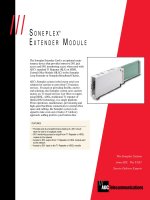Tài liệu How NetFilter Works pdf
Bạn đang xem bản rút gọn của tài liệu. Xem và tải ngay bản đầy đủ của tài liệu tại đây (26.2 KB, 4 trang )
How NetFilter Works
N
etFilter, or more commonly known by the name of the manipulation utility, iptables,
works, on the surface, similarly to the ipchains firewall code of earlier Linux kernels. The
first thing you need to understand about NetFilter is the concept of tables, chains, and
rules. Tables are used to provide certain types of functionality, which are defined in more
detail through this chapter. Chains define the path in which a packet can travel. The
chains are made up of rules, which define what action should be taken on packets that
match the rule. An easy way to think about it is that chains simply contain a list of the
rules, and tables contain the different types of chains.
N
etFilter has five builtin chains, which are grouped into the following three tables:
• Filter
• NAT
• Mangle
The filter table has three builtin chains that function in a similar fashion to the three
primary chains of ipchains. The function of the chains in the filter table is to test the
p
ayload of the packets (as well as other characteristics) and to accept or reject the packets
based on the results of that evaluation. The three builtin chains found in the filter table
are as follows:
• INPUT
• FORWARD
• OUTPUT
The INPUT chain evaluates packets that are destined for the firewall itself. The OUTPUT
chain evaluates packets that originate from the firewall. The FORWARD chain evaluates
packets that are traversing the firewall from one network interface to another. One of the
key differences between the chains in NetFilter and ipchains is that in ipchains all packets
going from one network interface to another traverse all three of the main chains
(INPUT, FORWARD, and OUTPUT). In NetFilter, however, they need only traverse the
FORWARD chain because that one is the one involved in forwarding packets between
interfaces. Figures 7-1
through 7-3 show the chain traversal.
Figure 7-1. NetFilter INPUT Chain Processing
[View full size image]
In Figure 7-1
, the packet from the source host 192.168.45.10 is directed to the firewall
itself. To reach the firewall, the packet must traverse the rules that are in the INPUT
chain of the filter table.
In Figure 7-2
, the traffic from host 192.168.45.10 is directed to the server at 10.1.1.1.
Typically, this also requires NAT to be present so that the server 10.1.1.1 has an external
address assigned to it, but this is beyond the scope of the current discussion. To reach the
system 10.1.1.1, the traffic must traverse the rules in the FORWARD chain of the filter
table because the traffic is going from one interface to another on the firewall.
Figure 7-2. NetFilter FORWARD Chain Processing
[View full size image]
In the final example of Figure 7-3
, a process on the firewall is communicating with the
host 192.168.45.10. The traffic must traverse the rules in the OUTPUT chain of the filter
table on the firewall before reaching its destination. Typically, unless the firewall is
filtering traffic in both directions, the OUTPUT chain is empty and all traffic is allowed
out from the firewall (which could be considered a security risk in certain environments).
Figure 7-3. NetFilter OUTPUT Chain Processing
[View full size image]
One of the key features that NetFilter has over ipchains is that NetFilter is a stateful
packet filter. Instead of requiring a specific inbound rule for every outbound connection,
the NetFilter code can identify return traffic that is related to previously seen outbound
traffic. This identification provides for a more efficient and secure firewall than is
possible with ipchains.
The NAT table performs Network Address Translation (and Port Address Translation)
functions on packets. This includes destination NAT (DNAT), source NAT (SNAT), and
masquerading. This table consists of three builtin chains:
• PREROUTING
• POSTROUTING
• OUTPUT
The PREROUTING chain processes packets before the local routing table is consulted,
and is used primarily for destination NAT. Destination NAT is where the destination
address of the IP packets is modified as they traverse the NAT device. DNAT can be
used to accomplish the following capabilities:
• Port forwarding
• Load balancing
• Transparent proxying
Port forwarding is where the firewall accepts packets for a destination host behind it and
forwards the packet unchanged to the destination. Load balancing is where the firewall
accepts packets destined for an externally visible IP address but distributes the
connections across multiple servers behind it to ensure that no one server gets
overloaded. Load balancing proves particularly useful in a web farm situation where
multiple web servers serve identical content;to ensure consistent performance or high
availability, the firewall directs connections to the various servers based on their current
connection load. Although this is not the only way that you can accomplish load
balancing, it is one of the more popular ways. Finally, transparent proxying is similar to
port forwarding, but instead of allowing the connection from the client to the server to go
unaltered, the firewall intercepts the connection. Although the client believes that it is
communicating with the destination server, it is actually communicating with a firewall
that is inspecting and potentially altering the packets before redirecting them to the
destination system. Although the NetFilter code does not perform the proxying itself, this
capability is possible using the Squid proxying software package.
Because the DNAT occurs in the PREROUTING chain of the NAT table, the INPUT and
FORWARD chains in the filter table see the real address of the destination system.
The POSTROUTING chain processes packets after the routing decision has been made,
and is primarily used for source NAT. This version of NAT modifies the source IP
address in the packets as they traverse the NAT device. Whereas the INPUT and
FORWARD chains see the modified IP address of a packet having undergone DNAT, all
three chainsINPUT, OUTPUT, and FORWARDsee the unmodified IP address of packets
undergoing SNAT.
Masquerading is a simple version of SNAT in which packets receive the IP address of the
output interface of the firewall as their source address. This functionality is the same as
N
AT overload in Cisco IOS code as well as the global command in the PIX.
The final table in NetFilter is the mangle table. This table enables the firewall to modify
numerous packet header fields, including Type of Service, Time To Live (TTL),
Differentiated Service Code Point (DSCP) field, TCP Mean Segment Size (TCPMSS),
and Explicit Congestion Notification (ECN). Additionally, this table allows for the
marking of packets for later processing by userdefined chains in the firewall rules using
the MARK match and MARK target. The MARK target is used to set special values on a
packet to perform additional operations on the packet. This value could include specific
routing considerations based on the MARK (using the iproute2 program) or bandwidth
limiting or classbased queuing as well as other operations. For kernel 2.4.18 and later,
this table has five builtin chains: PREROUTING, INPUT, FORWARD, OUTPUT, and
POSTROUTING. Previous kernel versions have two builtin chains: PREROUTING and
OUTPUT.
N
etFilter enables administrators to devise chains to extend the capabilities of the builtin
chains. Each userdefined chain must be associated with one of the three tables in
N
etFilter. As with ipchains, packets can be diverted to the userdefined chains, and when
the processing of the packet in the userdefined chain is complete, the packet processing
continues at the first rule after the one that sent the packet to the userdefined chain. The
next section covers the full path of packets through the various chains in NetFilter.









